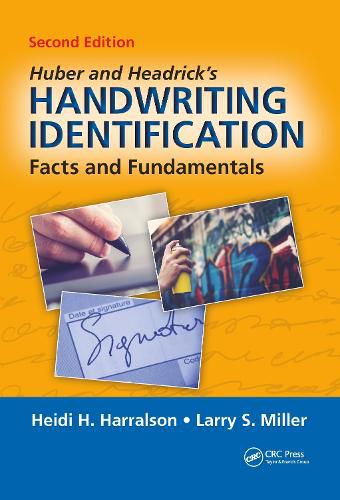Readings Newsletter
Become a Readings Member to make your shopping experience even easier.
Sign in or sign up for free!
You’re not far away from qualifying for FREE standard shipping within Australia
You’ve qualified for FREE standard shipping within Australia
The cart is loading…






Forensic document examination is the study of physical evidence and physical evidence cannot lie. Only its interpretation can err. Only the failure to find it, or to hear its true testimony can deprive it of its value. -Roy Huber
This is a comprehensive update of Huber and Headrick’s seminal work on handwriting examination. New coverage includes a review of forensic handwriting examination research, handwriting analysis training and proficiency, revised methods and procedures, an updated listing and clarification of terminology and electronic signatures, the analysis of digitized handwriting, and other related technological advances. The book includes updated photographs, several added illustrations, and advances in techniques based on the scientific research conducted in the area over the last 20 years.
Features of the new edition include:
The latest on electronic signatures, digital handwriting, automated handwriting verification, and the many advances in technology and research over the last two decades
An overview of the fundamentals of handwriting examination with updated discussion of the intrinsic and extrinsic variables associated with handwriting identification
A review of the criticism of handwriting expert opinions and methodology, addressing both the strengths and scientific limitations of the area
Fully revised while remaining true to the spirit and approach of original authors Roy Huber and A. M. Headrick
Addition of nearly 200 new references and new glossary terms representing advances in research and methods.
With extensive photographs to help clearly illustrate concepts, Huber and Headrick’s Handwriting Identification: Facts and Fundamentals, Second Edition serves as an invaluable reference to law libraries, practicing document examiners, forensic and criminal justice students, and every lawyer handling cases in which the authenticity of handwriting and documents might be disputed.
$9.00 standard shipping within Australia
FREE standard shipping within Australia for orders over $100.00
Express & International shipping calculated at checkout
Forensic document examination is the study of physical evidence and physical evidence cannot lie. Only its interpretation can err. Only the failure to find it, or to hear its true testimony can deprive it of its value. -Roy Huber
This is a comprehensive update of Huber and Headrick’s seminal work on handwriting examination. New coverage includes a review of forensic handwriting examination research, handwriting analysis training and proficiency, revised methods and procedures, an updated listing and clarification of terminology and electronic signatures, the analysis of digitized handwriting, and other related technological advances. The book includes updated photographs, several added illustrations, and advances in techniques based on the scientific research conducted in the area over the last 20 years.
Features of the new edition include:
The latest on electronic signatures, digital handwriting, automated handwriting verification, and the many advances in technology and research over the last two decades
An overview of the fundamentals of handwriting examination with updated discussion of the intrinsic and extrinsic variables associated with handwriting identification
A review of the criticism of handwriting expert opinions and methodology, addressing both the strengths and scientific limitations of the area
Fully revised while remaining true to the spirit and approach of original authors Roy Huber and A. M. Headrick
Addition of nearly 200 new references and new glossary terms representing advances in research and methods.
With extensive photographs to help clearly illustrate concepts, Huber and Headrick’s Handwriting Identification: Facts and Fundamentals, Second Edition serves as an invaluable reference to law libraries, practicing document examiners, forensic and criminal justice students, and every lawyer handling cases in which the authenticity of handwriting and documents might be disputed.